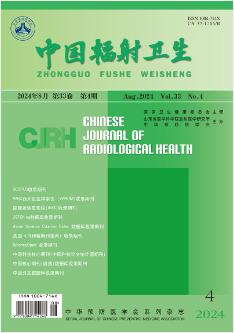Application on different contrast media concentration in the pancreatic CT angiography scanning
引用次数: 0
Abstract
Objective To compare the effects of the different contrast media concentration on the visualization of pancreatic arteries using 64-Detector Spiral CT. Methods 120 cases who underwent abdominal enhancement CT scanning were randomly divided into group A ( n = 60) and B ( n = 60). The contrast media concentration was 300 mgI/ml for group A and 370 mgI/ml for group B respectively, both groups shared the same contrast media dose algorithm and injection speed, with 0.5 gI/kg body weight and 4 ml/s respectively. Reformating the pancreatic arteries via MIP (maximum intensity projection), VR (volume rendering) and MPR (multi-planar reconstruction). Results The CT value of the abdominal aortic celiac opening of group B is significantly higher than A ( P < 0.01). The visualization scores of pancreatic arteriesin Group B are significantly higher than A ( P < 0.05). The visualization ratios of pancreatic arteriesin Group Bare higher than A, the differences of AIPDA、PIPDA、DPA、TPA、PMA、CPA between the 2 Groups have statistically significant ( P < 0.05). Conclusion Pancreatic arteries could have a better visualization by using 370 mgI/ml contrast media in pancreatic artery scanning. 摘要: 目的 比较不同浓度对比剂在 64 排螺旋 CT 胰腺动脉检查中的显示效果。 方法 将本院 120 例行腹部增强 CT 检查的患者随机分成 A、B 两组, 每组各 60 例, 分别注射 300 mgI/ml (A组) 和 370 mgI/ml (B组) 2 种浓度对比剂, 对比剂用量算法及注射速度两组一致, 分别为 0.5 gI/kg 体重和 4 ml/s。利用 MIP(最大密度投影)、VR(容积重现技 术)、MPR(多平面重组)等技术来显示胰腺动脉。 结果 B 组腹主动脉腹腔干开口处强化 CT 值明显高于 A 组, 差异 具有统计学意义 ( P < 0.01)。B 组各胰腺动脉显示评分均明显高于 A 组, 差异具有统计学意义( P < 0.05)。B 组各胰腺动脉显示率均高于 A 组, 其中 AIPDA、PIPDA、DPA、TPA、PMA、CPA 的差异具有统计学意义 ( P < 0.05)。 结论 当注射 370 mgI/ml 对比剂检查胰腺动脉时, 胰腺各动脉可获得较好的显示。不同造影剂浓度在胰腺CT血管造影扫描中的应用
Objective To compare the effects of the different contrast media concentration on the visualization of Pancreatic arts using 64 Detector Spiral CT. Methods 120 cases who understand dominant enhancement CT scanning were randomly divided into group A (n=60) and B (n=60) The contrast media concentration was 300 mgI/ml for group A and 370 mgI/ml for group B respectively, both groups shared the same contrast media do algorithm and injection speed, with 0.5 gI/kg body weight and 4 ml/s respectively Reforming the pancreatic arts via MIP (maximum intensity projection), VR (volume rendering), and MPR (multi planar reconstruction) Results The CT value of the arbitrary artistic opening of group B is significantly higher than A (P<0.01). The visualization scores of pancreatic arts in Group B are significantly higher than A (P<0.05). The visualization rates of pancreatic arts in Group Bare higher than A, the differences of AIPDA, PIPDA, DPA, TPA, PMA CPA between the 2 Groups has statistically significant (P<0.05). Conclusion Pancreative arts could have a better visualization by using 370 mgI/ml contrast media in Pancreative art scanning Abstract: Objective: To compare the display effects of different concentrations of contrast agents in 64 slice spiral CT pancreatic artery examination. Method: 120 patients who underwent abdominal contrast-enhanced CT examination in our hospital were randomly divided into two groups: A and B, with 60 patients in each group. Two concentrations of contrast agents, 300 mgI/ml (Group A) and 370 mgI/ml (Group B), were injected, with the same dosage algorithm and injection speed as the two groups, with 0.5 gI/kg body weight and 4 ml/s, respectively. Use techniques such as MIP (maximum density projection), VR (volume rendering), and MPR (multi plane reconstruction) to display pancreatic arteries. The enhanced CT values at the opening of the abdominal aorta and abdominal trunk in Group B were significantly higher than those in Group A, with a statistically significant difference (P<0.01). The display scores of pancreatic arteries in Group B were significantly higher than those in Group A, with statistically significant differences (P<0.05). The display rate of pancreatic arteries in Group B was higher than that in Group A, with statistically significant differences in AIPDA, PIPDA, DPA, TPA, PMA, and CPA (P<0.05). Conclusion: When injecting 370 mgI/ml contrast agent to examine pancreatic arteries, better visualization of each pancreatic artery can be achieved.
本文章由计算机程序翻译,如有差异,请以英文原文为准。
求助全文
约1分钟内获得全文
求助全文
来源期刊
CiteScore
0.80
自引率
0.00%
发文量
7142
期刊介绍:
Chinese Journal of Radiological Health is one of the Source Journals for Chinese Scientific and Technical Papers and Citations and belongs to the series published by Chinese Preventive Medicine Association (CPMA). It is a national academic journal supervised by National Health Commission of the People’s Republic of China and co-sponsored by Institute of Radiation Medicine, Shandong Academy of Medical Sciences and CPMA, and is a professional academic journal publishing research findings and management experience in the field of radiological health, issued to the public in China and abroad. Under the guidance of the Communist Party of China and the national press and publication policies, the Journal actively publicizes the guidelines and policies of the Party and the state on health work, promotes the implementation of relevant laws, regulations and standards, and timely reports new achievements, new information, new methods and new products in the specialty, with the aim of organizing and promoting the academic communication of radiological health in China and improving the academic level of the specialty, and for the purpose of protecting the health of radiation workers and the public while promoting the extensive use of radioisotopes and radiation devices in the national economy. The main columns include Original Articles, Expert Comments, Experience Exchange, Standards and Guidelines, and Review Articles.

 求助内容:
求助内容: 应助结果提醒方式:
应助结果提醒方式:


